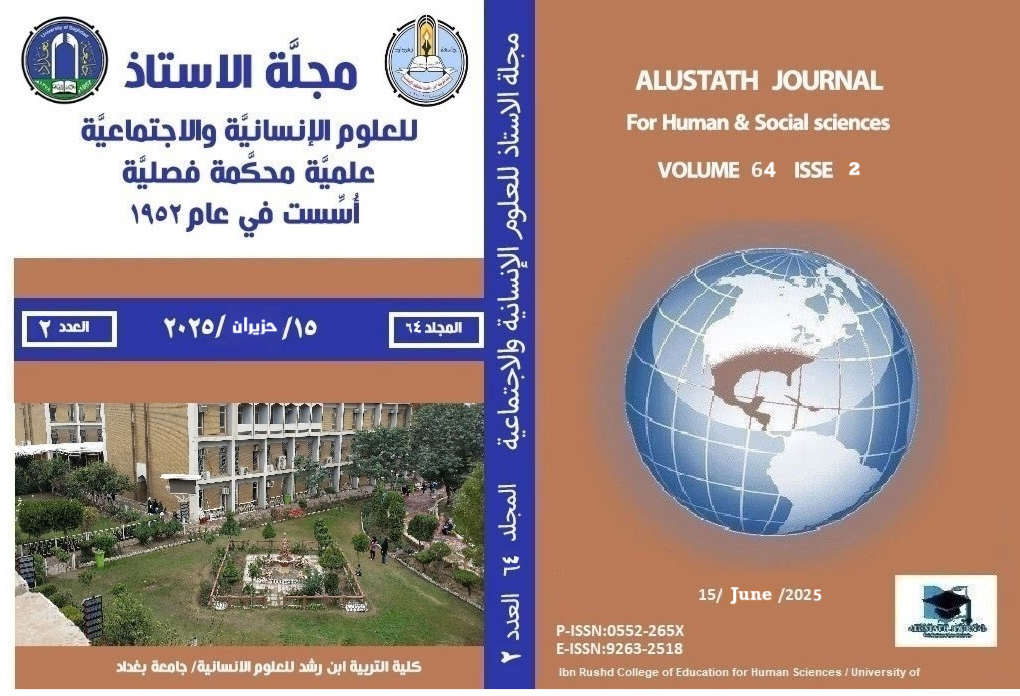Morphological Phenomena in the Dictionary of Eloquent Origins of Colloquial Words by Muhammad Nasser Al-Aboudi: Analysis and Evaluation
DOI:
https://doi.org/10.36473/mrvcdt11Keywords:
morphological phenomena, dialect Najdi, spoken language, Al-Aboudi, formula.Abstract
A close examination of Muhammad Al-Aboudi’s Lexicon of Classical Origins of Colloquial Terms reveals that Najdi vernacular has preserved many of the classical Arabic morphological patterns and their meanings. Some forms have undergone slight changes from their original classical structures, yet these modifications do not place them outside the bounds of authentic Arabic usage. In this study, I will highlight a selection of commonly used nominal and verbal morphological patterns found in the Najdi dialect. Research problem: There are morphological meters in colloquial Najdi that still retain their connotations that were in the classical language, and there is a need to uncover them. The importance of the research: examining the most important reasons that contributed to the perpetuation of the meanings of some morphological structures in the Najdi spoken language. Research procedures: The research is limited to the colloquial expressions of the people of Najd in the modern era through the Al-Aboudi dictionary.
Downloads
References
One: alquran alkarim.
Two: Books and research.
• Ibn al-Atheer, Abu al-Sa’adat al-Mubarak Muhammad ibn Muhammad al-Jazari, (1420 AH), Al-Badi’ fi Ilm al-Arabiyah, edited by: Fathi Ahmad Ali al-Din, 1st edition, Mecca: Umm al-Qura University.
• Ibn Manzur, Muhammad bin Makram bin Ali, (1414 AH), Lisan al-Arab, 3rd edition, Beirut: Dar Sader.
• Ibn Ya’ish, Ya’ish Ibn Ali Ibn Ya’ish, (2001 AD), Sharh al-Mufassal by Al-Zamakhshari, presented by: Emil Badi’ Yaqoub, 1st edition, Beirut: Dar Al-Kutub Al-Ilmiyyah.
• Abu Hayyan, Muhammad bin Yusuf Al-Andalusi, (B.T.), Al-Bahr Al-Muhit fi Al-Tafsir, edited by: A Group of Researchers, 1st edition, Beirut: Dar Al-Kutub Al-Ilmiyyah.Al-Arnaouti, Dr. Zuhair Muhammad, (2012 AD), the significance of (wastefa’al) on exaggeration in the Holy Qur’an, University of Baghdad, Ibn Rushd College of Education for the Humanities, Alustath Journal for the Humanities and Social Sciences, Issue 200, 1.
• Al-Azhari, Abu Mansour Muhammad bin Ahmed, (2001 AD), Refinement of the Language, edited by: Muhammad Awad Marib, 1st edition, Beirut: Dar Revival of Arab Heritage.
• Al-Anbari, Abu Al-Barakat Abdul Rahman bin Muhammad, (2003 AD), Fairness in Issues of Disagreement between Basra and Kufic Grammarians, 1st edition, Modern Library.
• Anis, Ibrahim, (1992), On Arabic Dialects, 8th edition, Egypt: Anglo-Egyptian Library.
• Al-Jurjani, Abd al-Qahir bin Abd al-Rahman, (1987 AD), The Key to Morphology, edited by: Ali Tawfiq al-Hamad, 1st edition, Beirut: Al-Resala Foundation.
• Al-Hadithi, Khadija Abd al-Razzaq, (1965 AD), Morphological Structures in the Book of Sibawayh, 1st edition, Baghdad: Al-Nahda Library Publications.
• Hassan, Tammam, (2000), Principles: An Epistemological Study of Linguistic Thought among the Arabs, Dr. I, the world of books.
• Ibn al-Atheer, Diya al-Din, (1420 AH), The Proverb in the Literature of the Writer and Poet, edited by: Muhammad Mohi al-Din Abd al-Hamid, D. I., Beirut: The Modern Library for Printing and Publishing.
• Hassan, Tammam, (D.D.), Research Methods in Language, D.D., Egypt: Anglo-Egyptian Library.
• Hassan, D. Sajida Mazban, (2017 AD), Dispensation in the Structures of the Crowds of the Few and the Many in the Holy Qur’an between Rejection and Acceptance, University of Baghdad, College of Education Ibn Rushd for the Humanities, Alustath Journal for the Humanities and Social Sciences, Volume One, Issue 222, 1.
• Al-Hamdani, Khadija Zabbar, (2010 AD), Morphological Research, 1st edition, Amman: Dar Safaa for Publishing and Distribution.
• Dawoud, Ahmed Jaafar, (2021), The ostensible form in the Holy Qur’an, a morphological and semantic study, Wasit Journal for Humanities and Social Sciences, Volume 17, Issue 47.
• Al-Raghib, Al-Hussein bin Muhammad Al-Isfahani, (1412 AH), Al-Mufradat fi Gharib Al-Qur’an, edited by: Safwan Adnan Al-Daoudi, 1st edition, Beirut: Dar Al-Qalam, Dar Al-Shamiya.
• Al-Radi, Muhammad bin Al-Hasan, (1975 AD), Sharh Shafiya Ibn Al-Hajib, edited by: A Group of Researchers, D. I., Beirut: Dar Al-Kutub Al-Ilmiyyah.
• Al-Zamakhshari, Mahmoud bin Omar, (1993 AD), Al-Mufassal fi Sanaat al-Arab, edited by: Dr. Ali Bou Melhem, 1st edition, Beirut: Al-Hilal Library.
• Al-Samarrai, Fadel Saleh, (2007), The Meanings of Buildings in Arabic, 2nd edition, Jordan: Dar Ammar.
• Sibawayh, Amr bin Othman bin Qanbar, (1988 AD), Al-Kitab, edited by: Abdul Salam Muhammad Haroun, 3rd edition, Cairo: Al-Khanji Library.
• Al-Suyuti, Jalal Al-Din, (1998 AD), Al-Mizhar fi Linguistic Sciences and its Types, edited by: Fouad Ali Mansour, 1st edition, Beirut: Dar Al-Kutub Al-Ilmiyyah.
• Ibn al-Anbari, Muhammad bin al-Qasim, (1981 AD), Masculine and Feminine, edited by: Muhammad Abd al-Khaleq Adima, B. T., Egypt: Ministry of Endowments.
• Shalash, Hashem Taha, (1971), Verb Weights and Their Meanings, Dr. I, Al-Najaf Al-Ashraf: Al-Adab Press.
• Al-Tabarsi, Al-Fadl bin Al-Hasan, (1966 AD), Protest, edited by: Mr. Muhammad Baqir Al-Kharsan, Dr. Edition, Al-Najaf Al-Ashraf: Dar Al-Numan for Printing and Publishing.
• Ati, Ali Abd Ali, 2024, Semantic Research into the Story of Taloot and Goliath in the Holy Qur’an, Journal of the College of Education for Girls, University of Baghdad, Volume 35, Issue 2.
• Abdel Tawab, Ramadan, (1999), Chapters on Arabic Jurisprudence, 6th edition, Egypt: Al-Khanji Library.
• Al-Aboudi, Muhammad Nasser, (2009), Dictionary of Eloquent Principles of Colloquial Words, or What the Centuries Did to Arabic in Its Infancy, ed., Riyadh: King Abdulaziz Library.
• Al-Fakhri, Saleh Selim, (1996), Conjugation of Verbs, Infinitives, and Derivatives, ed., Cairo: Esmi Publishing and Distribution.
• Al-Farra’, Yahya bin Ziyad, (d. T.), Meanings of the Qur’an, edited by: Ahmed Youssef and others, 1st edition, Egypt: Dar Al-Masria for Writing and Translation.
• Al-Farahidi, Al-Khalil bin Ahmed, (B. T.), Al-Ain, edited by: Mahdi Al-Makhzoumi, and Ibrahim Al-Samarrai, D. T., Al-Hilal Library House.
• Al-Faqir, Saif al-Din, and Aliwi, Hafez, 2024, Morphological and grammatical structures marked by the rule of good according to Sibawayh, Journal of Arts, University of Baghdad, No. 149.
• Al-Mutanabbi, Ahmed bin Al-Hussein, (1983 AD), Diwan Al-Mutanabbi, d. I, Beirut: Dar Beirut.
• Ibn al-Sarraj, Muhammad bin al-Sirri, (B.T.), Fundamentals of Grammar, edited by: Abdul Hussein al-Fatli, Dr. I, Lebanon: Al-Resala Foundation.
• Ali, Muhammad Hussein, (2016 AD), The Story of My Son Adam, a Linguistic Study, University of Baghdad, College of Education, Ibn Rushd for Human Sciences ،Alustath Journal for the Humanities and Social Sciences, Issue 216, Volume 1.
• Shams al-Din, Israa Amer, (2018), The exchange between the scholars of the ancients and the scholars of the moderns has a new vision in its education, University of Baghdad, College of Education, Ibn Rushd for the Humanities, Alustath Journal for the Humanities and Social Sciences, Issue 227, December.
• Ibn al-Sakit, Yaqoub bin Ishaq, (1987 AD), Reform of Logic, edited by: Ahmed Muhammad Shaker and Abdul Salam Haroun, 4th edition, Egypt: Dar al-Maaref, Egypt.
• Ibn Jinni, Othman, (1954 AD), Al-Mansif, 1st edition, Old Heritage Revival House.
• Ibn Khalawayh, Al-Hussein bin Ahmed, (1979), Not in the Words of the Arabs, edited by: Ahmed Abdul Ghafour Attar, 2nd edition, Mecca.
• Ibn Duraid, Muhammad ibn al-Hasan al-Azdi, (1987 AD), Jamharat al-Lughah, edited by: Ramzi Munir Baalbaki, 1st edition, Beirut: Dar al-Ilm Lil-Malayin.
• Ibn Ashour, Muhammad Al-Taher, (1997 AD), Liberation and Enlightenment, (Liberating the True Meaning and Enlightening the New Mind from the Interpretation of the Glorious Book), D. I., Tunisia: Al-Dar Al-Tunisia.












